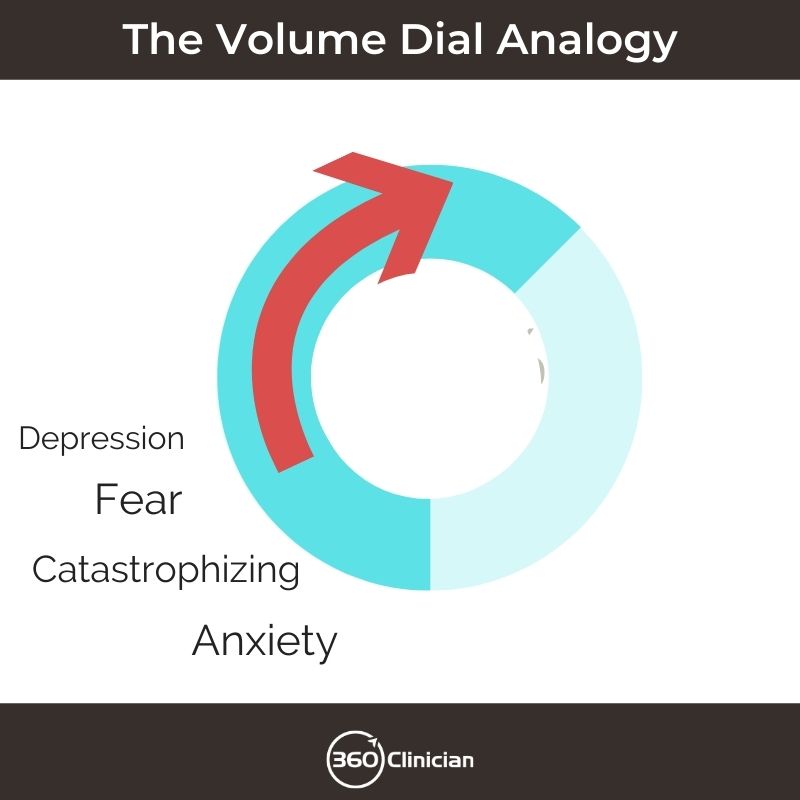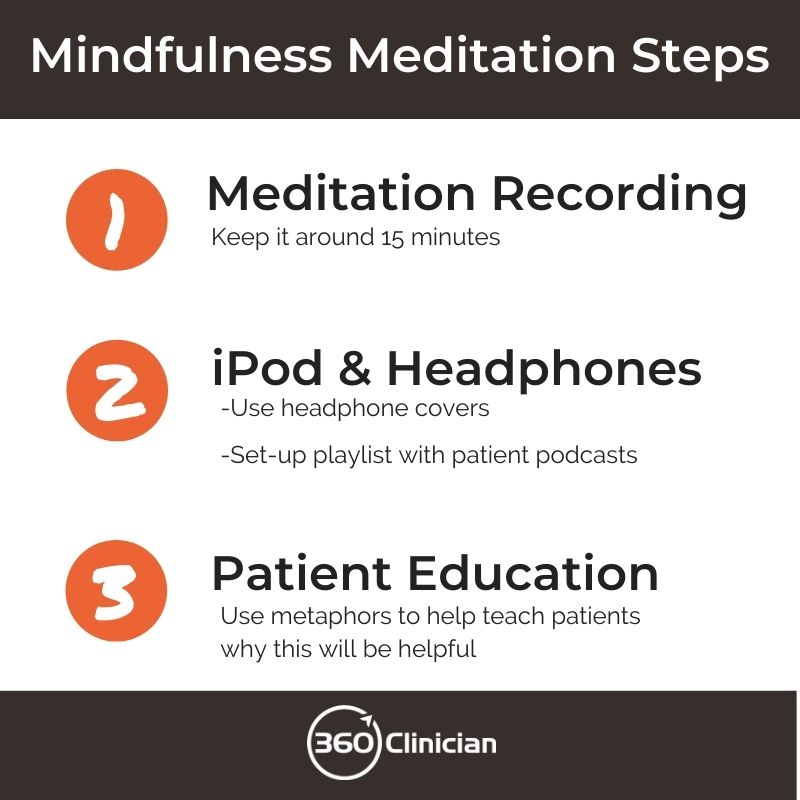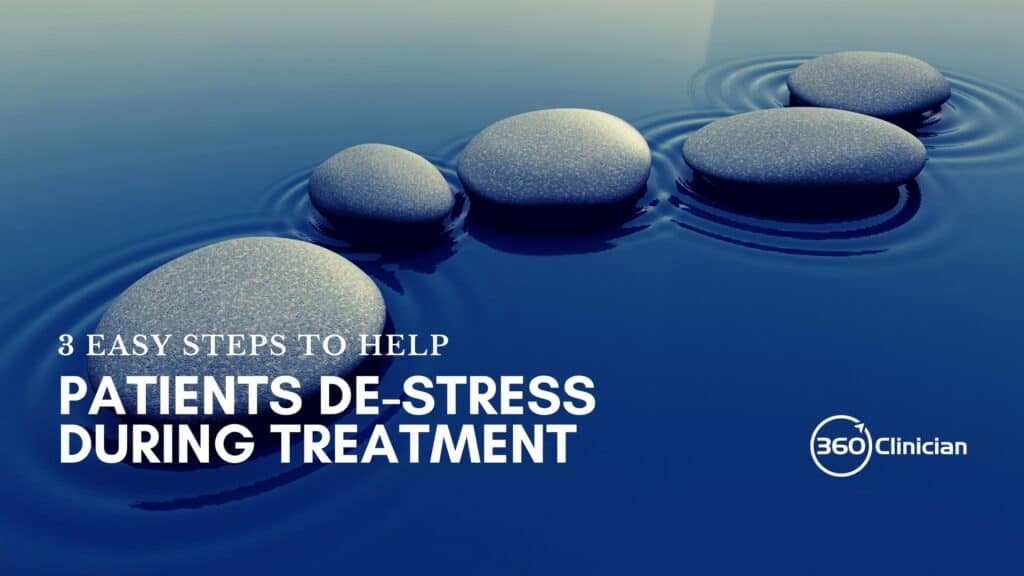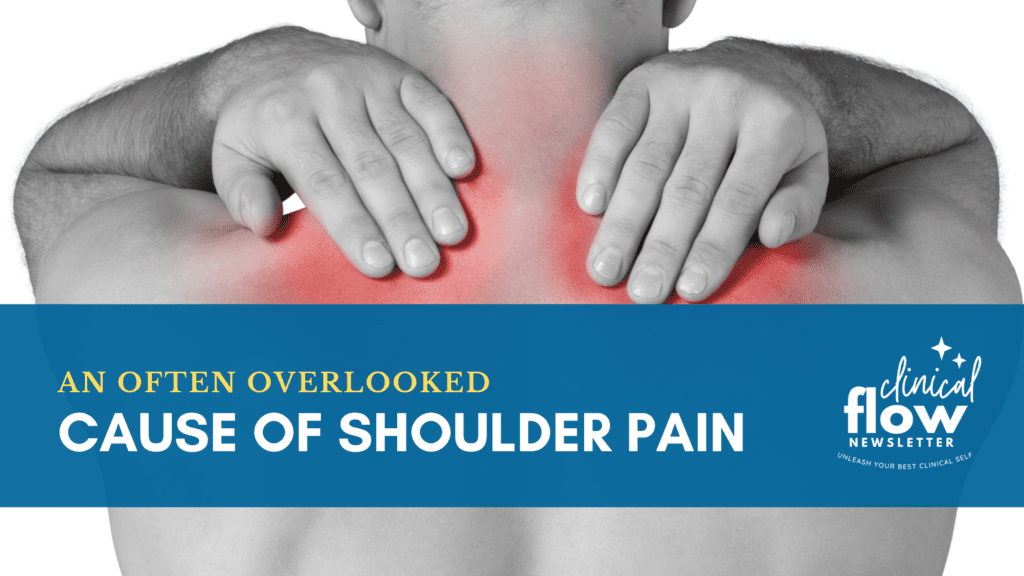Whether stress comes from the limitations of a clients injury or other psychosocial factors, what specific tools do you provide your patients to help them better cope with stress in their lives?
Have you ever wondered if there was something more that could be done with patients as they’re laying at the beginning or end of treatment with a hot pack (or insert another modality)?
Could we use that 15 minute slot for something more?
I wonder if we can be taking those opportunities to provide specific pain education training to our patients. Ongoing research continues to show the importance of patient education in the recovery process. But how often are we educating patients to interact differently with their pain experience and equip them with skills to do just that?
In this article, I share 3 easy steps to help you incorporate mindfulness based meditation training in the clinic environment so as to help patients more effectively decrease their pain experience.
Pain Increases Stress
Pain muddies our thinking. It becomes difficult to maintain perspective when we’ve flared up a chronic issue and our motivation wears thin. And when our thinking becomes clouded we can become more susceptible to emotions that can “up-regulate” our nervous system and delay our body’s healing mechanisms.
To help “down-regulate” our patients’ nervous system, we need to help them to learn specific skills to de-stress and create a different relationship with their body. I know that doesn’t sound like an easy task, but there’s a simple way to make that happen. It’s called mindfulness meditation.
Mindfulness meditation has been conceptualized as a “state in which one is highly aware and focused on the reality of the present moment, accepting and acknowledging it, without getting caught up in thoughts that are about the situation or in emotional reactions to the situation.” 1
There are a number of different types of mindfulness meditation. One of the most practiced and studied styles is the Body Scan meditation, popularized by Jon Kabat-Zinn. It forms the foundation of mindfulness based stress reduction (MBSR) programs used across North America for chronic stress and pain.
3 Steps to Do Body Scan Meditations in the Clinical Environment
Here’s my recommended 3 steps to get patient body scan meditations up and running in your clinical environment:
Step 1: A Good Mindfulness Meditation Recording
The original mindfulness meditation recordings, based on mindfulness based stress reduction (MBSR) training were approximately 45 minutes in length. And those meditations are very good, but they are long and not practical within a clinical environment. I’ve tried a number of different meditations and I’ve settled on one that’s only 20 minutes in length and is soothing to listen to. It was developed at UC San Diego.
Here’s a link to the body scan meditation [Click Here].
Step 2: Get out the iPod and create a meditation playlist
This is a simple step-get an iPod or other media player and download and the mp3 meditation a create new clinic podcast playlist. I’d recommend purchasing headphones that are easily slipped on and off the ears to improve patient comfort. Obviously we need a way for the patient to tune out the extraneous noise and not disturb other patients. It would be ideal to have the patient in a private room, but even placing a folded towel over their eyes will help to decrease extraneous sensory inputs. To help promote good hygiene headphone covers should be used. They can be bought inexpensively on Amazon.
Step 3: Educate the Patient
Without education in the pain sciences, patients can sometimes mistrust the process of doing a “meditation”. Clinically, I’ve found it helpful to bridge that gap by using some basic pain education metaphors and relating how mindfulness meditation can help. As Melzack 2 articulated:
We are so accustomed to considering pain as a purely sensory phenomenon that we have ignored the obvious fact that injury does not merely produce pain; it also disrupts the brain’s homeostatic regulation systems, thereby producing “stress” and initiating complex program to reinstate homeostasis. By recognizing the role of the stress system in pain processes, we discover that the scope of the puzzle of pain is vastly expanded and new pieces of the puzzle provide valuable clues in our quest to understand chronic pain.
We are so accustomed to considering pain as a purely sensory phenomenon that we have ignored the obvious fact that injury does not merely produce pain; it also disrupts the brain’s homeostatic regulation systems, thereby producing “stress” and initiating complex program to reinstate homeostasis. By recognizing the role of the stress system in pain processes, we discover that the scope of the puzzle of pain is vastly expanded and new pieces of the pruzzle provide valuable clues in our quest to understand chronic pain.
And that’s part of our role with our patients-to help them understand that pain is not just a purely sensory phenomenon, but that it becomes a much bigger puzzle that needs to be explored and addressed.
One of the metaphors that I will often use initially is that of the volume dial on a stereo. I explain that when we are in pain, and experience fear, anxiety and the host of other emotions that can often accompany injury and disability, the volume dial increases and our pain experience becomes increasingly intense and more central to our reality.
Mindfulness meditation and specifically the Body Scan helps develop our mind’s ability to distance ourselves from our pain thereby turning down the dial and “down-regulating” our stress response. To the patient, I explain that this basic breathing and awareness exercise can help to turn down that dial and help their bodies to maximize its healing potential.

Here’s a Summary
To summarize I’ve created the graphic that outlines the 3 steps shared in this article.

And so there we go…
3 easy steps to begin engaging and educating our patients on a specific skill set to help de-stress and in turn enhance their body’s innate healing processes.
To better flow,Andrew
If you enjoyed this article and want to stay up-to-date on my newest content, sign up for the Clinical Flow Newsletter! There you will have access to special offers, exclusive content, and be part of a growing community of clinicians with the purpose of improving yourself and your clinical practice.
Sources
- Bishop, S. What Do We Really Know About Mindfulness-Based Stress Reduction?. Psychosomatic Medicine 64.71-84 (2002)
- Melzack, R. Pain and the Neuromatrix in the Brain. Journal of Dental Education. Vol 65, 12. December 2001, 1378-1382.


